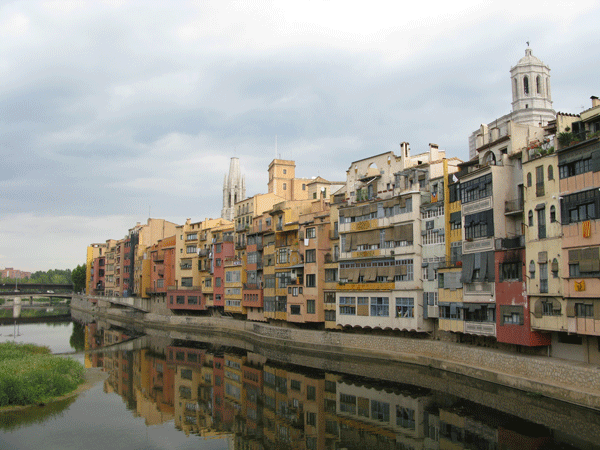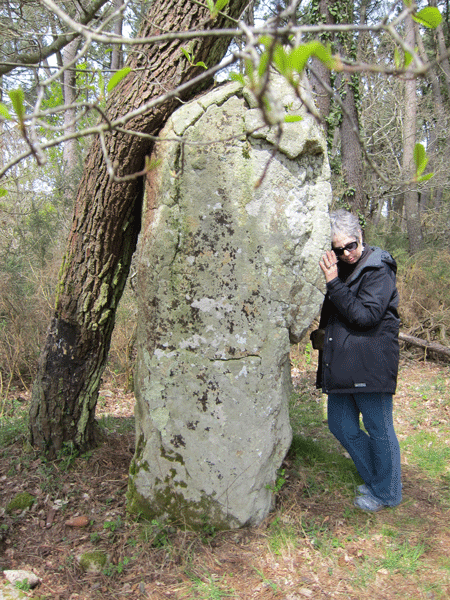I Heard The Call of Girona
by Elyn Aviva
I heard the Call whisper to me as I pressed my hands against its crumbling grey stones. I was standing in the medieval Jewish quarter in Girona, aka “The Call,” a Catalan word based on the Hebrew qahál, which means “a meeting or a gathering.” And gather they did, long ago, the Jewish residents of Girona, Spain, in the winding streets and narrow alleys, in the covered corridors and on the steep-stepped sidewalks. Hurrying to work, to play, to study, hurrying to synagogue to pray. They arrived in 898 and for 500 years they were integrated into the city—except for those dreadful times like 1391 when suddenly they weren’t and they became the targets of violence and repression.
I had seen their traces in the Museum of Jewish History, housed in what had been the Girona synagogue until 1492 when all the Jews were expelled, ending 500 years of coexistence. Suddenly they were gone, all gone, forced from their temple, their homes, their land, and sometimes from their faith.
I had seen what little they had left behind, displayed in the museum’s evocative exhibits. One gallery held fourteenth-century limestone gravestones, engraved in Hebrew (“Josef, a young child who was a lover of joy, the son of Rabbi Jacob. May he be present in Glory, protected by his Rock and his Redeemer" and “the honored Estelina, wife of the distinguished and upright Bonastruc Josef. May she have her mansion in the Garden of Eden”). Other galleries were filled with rare artifacts, facsimiles, and borrowed objects, with modern reconstructions and pictorial displays. Nothing else remained of the once-thriving community—except its reputation. Not even time’s amnesia could silence that, for Girona had been the center of a famous medieval school of Kabbalists, those mystical philosophers who believed the universe was made manifest in ten emanations.
The most famous Kabbalist of that time was Rabbi Moses ben Nahman (also known as Ramban or Nahmanides), born in Girona in 1194 and died in the Holy Land in 1270. In 1263 King James I of Aragón (a personal friend) summoned him to Barcelona to defend Jewish beliefs against the Dominican Pablo Christiani, a Jewish convert to Christianity. King James awarded Nahmanides a prize and declared that never before had he heard "an unjust cause so nobly defended."But the Dominicans charged Nahmanides with blasphemy and he was banished, a banishment that turned into permanent exile in the Holy Land. In a letter to his family, he exclaimed, "I am the man who has felt the stab of pain. I left behind the table spread for me, I went far from my friends and companions, because the journey is long and full of trials. I, who was a prince among my brothers, live now in an inn for travelers. House and inheritance too I left behind me, and I left my soul and my spirit there with the sons and daughters that I loved, and with the little children I looked after."
I heard faint whispers, like a gentle breath, blow through the Call. Rahel lived here in the eleventh century and sold a vineyard, signing the deed in Hebrew. Not only could she write her name but she could sell goods on her own. And Bonafilla, who lived here in the thirteenth century, was a successful businesswoman. And Azriel of Girona lived here too, a well-known member of the Kabbalist circle who spoke several languages. And Messullam ben Selomah de Piera, a Kabbalist, poet, and philosopher, friend of Moses ben Nahman and Azriel. And Jacob ben David Bonjorn, court physician and astronomer to King Peter IV in the fourteenth century. And Blanca, a fifteenth century Jewish woman who converted to Christianity. She had five children, four of whom were Christian and one who was a Jew. They all lived here once—lived and died if, unlike Nahmanides, they were fortunate enough not to be expelled. Once the streets had been full of craftsmen and merchants, scholars and traders, mothers and children—and then suddenly they were gone and only traces remained.
I put my ear against the ancient stones, listening to the echoes of a previous age. I looked up to the high blind wall, its windows shuttered long ago (to keep the Jews from looking out and casting spells upon the Christians walking by below). Incited by fanatic clergy and jealous debtors, the municipal council had sealed off the Jews in the fourteenth century, leaving only a single entrance to the Call. Shadows abounded in this sad and solemn place.
The Call whispered to me—it spoke of perseverance, of all things in their time, of cycles and recycles. It spoke of physical constraint but spiritual expansion. Once, only married Jewish men of a certain age were permitted to study Kabbalah, but now Madonna studies it (or thinks she does) and popular self-help books extol its virtues. There’s even talk in Girona of reestablishing the medieval school. I wondered what Ramban would have thought, or Azriel or Messullam.
The whispers shifted in tone, grew louder all around me. I was no longer alone, listening to the echoes of a previous age. A large Israeli tour group had crowded around the entrance to the museum, their guide describing in rapid-fire Hebrew the aching history of the place.
I turned and walked away, down the sloping Carrer de la Força, which follows the Via Augusta, “the Roman road of conquest,” until I reached the river Onyar and the bustling Ramblas that ran along its side. I sat at a bright green umbrella-shaded table and ordered thick hot chocolate with whipped cream, as if this sweet indulgence could wash away the bitter taste of faded glory and forced expulsion. Outside the Call, the day was pleasant and full of color.
Elyn Aviva is a writer, fiber artist, and transformational traveler. She says, “I had the weirdest feeling while writing this piece that I was engaged in a ritual act—like I was reciting the mourners’ kaddish or honoring the yartzeit.” Currently living in Sahagún (León), Spain, Elyn is fascinated by pilgrimage and sacred sites. Her PhD in anthropology was on the modern Camino de Santiago in Spain. Aviva is co-author of Powerful Places in Catalonia (which has a chapter on Girona), Powerful Places on the Caminos de Santiago, Powerful Places in Scotland, and other books on pilgrimage and journey. To learn more, go to www.pilgrimsprocess.com and www.fiberalchemy.com






